Correct Way To Tune The Carburetor On A Chainsaw
- January 30, 2024
- 0 comment
Tuning the carburetor on your chainsaw is crucial for ensuring optimal performance, longevity, and safety. While it may seem daunting at first, understanding the process and carefully following the steps can make this task manageable, even for those less experienced. Below is a comprehensive guide on how to properly tune the carburetor on a chainsaw, incorporating expert advice and proven techniques.
Understanding the Basics
Before diving into the fine-tuning of your chainsaw’s carburetor, it’s essential to grasp the fundamentals. Most chainsaws are equipped with three critical adjustment screws — the low-speed, high-speed, and idle screws. Each plays a vital role in your chainsaw’s performance. Prioritize the following steps to set the stage for a successful tuning:
- Make sure the bar and chain are securely attached and tensioned correctly. An improperly fitted bar and chain can significantly skew the carburetor’s adjustments.
- The condition and proper placement of the air filter are paramount as they directly influence the carburetor’s operation.
- Before making any adjustments, run the chainsaw at idle and give it a few revs for about a minute to ensure it’s at the right temperature for tuning.
When tuning your chainsaw’s carburetor, prioritizing safety is paramount. Conduct the tuning process in a well-ventilated area to prevent the buildup of harmful exhaust fumes, which can pose serious health risks. Additionally, it’s important to acknowledge that chainsaws generate high noise levels during operation, which can be detrimental to your hearing over time. To protect your ears while ensuring you can still hear and respond to the subtle changes in the engine’s sounds during adjustments, always wear appropriate hearing protection. This dual approach ensures you’re safeguarding your health while maintaining the precision needed for effective carburetor tuning.
Adjusting the Screws
Understanding Limiter Caps
Modern chainsaws often feature limiter caps on adjustment screws to prevent users from making extreme adjustments that could damage the engine or render the chainsaw unsafe. These caps allow minor adjustments (usually about half a turn in either direction), providing some room for fine-tuning while safeguarding the engine’s integrity.
If your model requires a specialty screwdriver (like many Husqvarna models), you may need to visit a dealer.
Tuning the Low-Speed Screw
Mastering the low-speed screw adjustment is essential for an optimal fuel-air mix at idle, ensuring smooth operation and responsive throttle engagement.
Begin with the idle screw, fine-tuning it until the chain initiates movement, then slightly retract it to stop the chain. This step guarantees safe chainsaw operation without unintended activation.
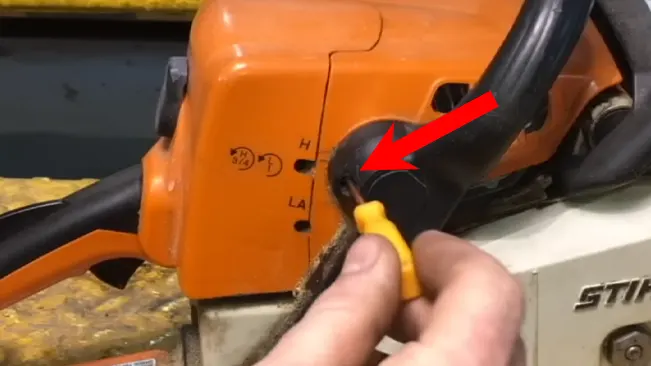
The low-speed screw, typically nearest to the engine and away from the air filter, is your focus for fine adjustment. Listen closely to the engine’s rhythm as you tweak the screw, aiming for the highest idle RPM where the engine operates smoothly without engaging the chain. Once you find this peak, gently turn the screw counterclockwise until the RPMs slightly decrease, marking the ideal idle setting.
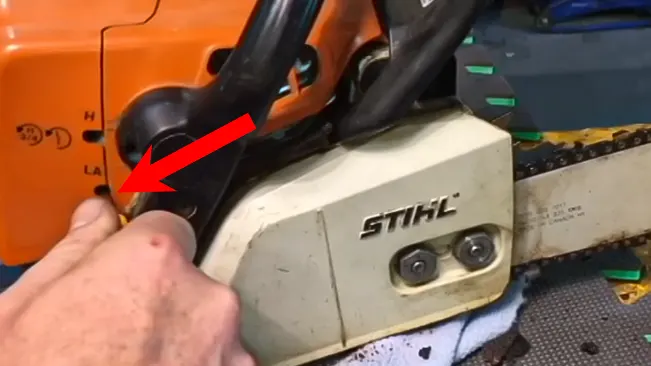
If your chainsaw isn’t clearly labeled, remember the low-speed screw is closest to the engine. Begin adjusting, noting that turning the screw in will decrease RPMs. If turned too far, the RPMs will drop significantly. Conversely, turning it out will increase the RPMs until they peak and then start to fall again. Find the midpoint between these fluctuations – this is the sweet spot of optimal idling speed. From here, incrementally adjust the screw outwards until the RPMs just begin to decrease, then set it.
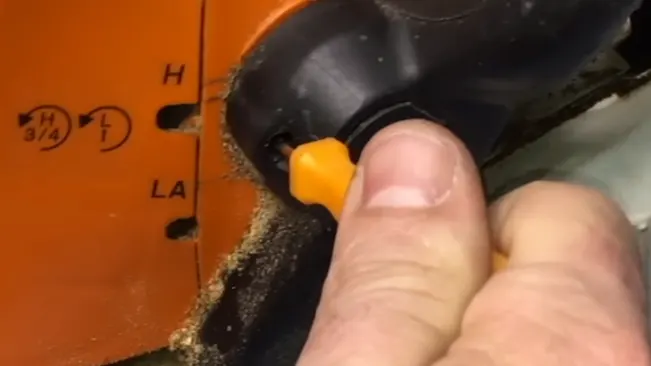
For chainsaws with persistent idling issues or lacking responsiveness, removing the limiter cap on the low-speed screw may be necessary for broader adjustment range. If this is the case, and adjustments don’t yield the expected response, consult online resources for guidance on removing the limiter cap for your specific chainsaw model and retry the tuning process. If issues persist, it may indicate a deeper problem with the chainsaw, necessitating further investigation or professional servicing.
Tuning the High-Speed Screw
Adjusting the high-speed screw on a chainsaw is a delicate process, critical for managing the maximum RPMs. This procedure, while seemingly straightforward, holds the engine’s integrity in its balance. An improperly tuned high-speed screw can lead to over-revving, risking severe engine damage.
For precision in this task, a digital tachometer proves indispensable. This device offers exact RPM measurements without the need for a direct engine connection. Simply holding it near the spark plug provides accurate readouts on its digital display, ensuring you’re informed about the engine’s speed in real-time.
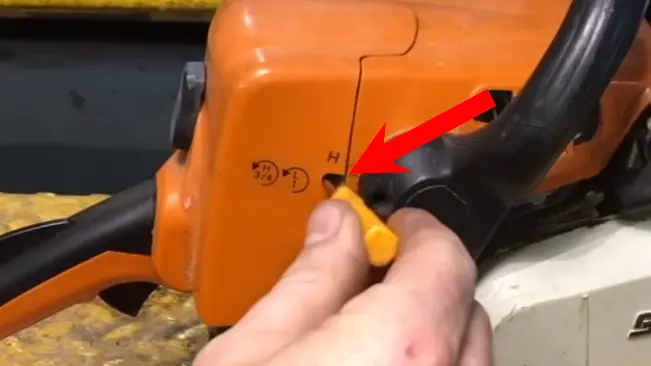
The high-speed screw’s role is to modulate the chainsaw’s top speed. When the throttle is fully engaged, the screw’s adjustments can either increase or decrease the engine’s RPMs. Tightening the screw escalates the speed, while loosening it reduces the pace. However, excessive tightening can push the engine beyond safe operational limits, potentially causing catastrophic failure.
In scenarios where your chainsaw model includes a limiter cap, it’s wise to adhere to its preset boundaries. The limiter cap is engineered to prevent over-tightening, safeguarding the engine from reaching hazardous speeds. If your chainsaw lacks this feature, consulting online resources for the recommended initial high-speed screw settings specific to your model is advisable. These factory settings are meticulously calculated to avoid over-revving, offering a baseline for safe operation.
Digital tachometers are not just functional; they’re affordable and accessible. Available online for under $14, these gadgets are a small investment for significant peace of mind. If obtaining one is not an option, and your chainsaw comes with a limiter cap, trust its design. Engage the chainsaw, rev it up, and adjust the screw up to the point where the limiter cap restricts further tightening. This position should represent the maximum safe speed, as determined by the manufacturer.
If the limiter cap is absent, and you’re left to manually adjust the high-speed screw, turning to online resources once more becomes essential. Search for the initial setting recommendations for your chainsaw’s make and model. These guidelines, like the factory settings, are designed to prevent over-revving. Once you find the information, adjust the screw accordingly, and trust in these expertly determined specifications to maintain your chainsaw’s engine within safe operational limits.
Fine-Tuning and Testing
Post-adjustment, rigorous testing and fine-tuning are paramount to ensure your chainsaw operates optimally:
Start your chainsaw and observe its behavior at different states: idling, accelerating, and at full throttle. The sound should be smooth and steady, with no irregularities or signs of strain.
At idle, the chain should remain stationary, a sign of correct idle speed setup. Upon acceleration, look for a swift and fluid chain movement, an indicator of a well-calibrated carburetor.
Incorporate a digital tachometer into your testing process, if available. It’s not merely a performance check but a crucial step for verifying that the RPMs are within your chainsaw’s designated safe range, safeguarding against premature wear or hazardous operation.
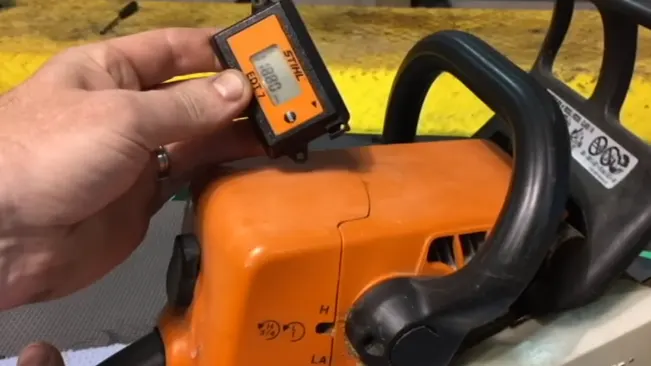
A practical example: Consider a chainsaw with a maximum RPM limit of 12,500. After initial adjustment, testing might reveal the RPMs are around 1,000 below the maximum. While it might seem less than optimal, operating slightly below the maximum RPM is preferable to exceeding it, striking a balance between performance and engine health.
Trust in the initial settings, especially if they yield RPMs slightly below the maximum. It’s a safer bet to err on the side of caution, avoiding the risks associated with over-revving. Remember, a chainsaw operating slightly below its top RPM can still perform efficiently and is often a more prudent choice.
Understanding the Fast Idle Mechanism
When starting the chainsaw, the choke position engages a fast idle, which stays engaged until the throttle is blipped. This feature simplifies starting and restarting the chainsaw, especially when it’s hot, making the process smoother and more user-friendly.
Troubleshooting Section
Even the most meticulously tuned chainsaws can encounter issues. Here’s how to troubleshoot some common problems:
- Chainsaw Won’t Start After Tuning: If your chainsaw won’t start after tuning, the problem could be with the fuel mix. Ensure it’s correctly mixed and fresh, as old or improperly mixed fuel is often the cause. Another potential culprit is the spark plug. Check it for fouling or wear, and clean or replace it if necessary. Also, revisit your idle and low-speed screw settings, as an overly lean mixture can prevent the chainsaw from starting.
- Chainsaw Starts but Dies Shortly After: When a chainsaw starts but dies shortly after, it might indicate an issue with the idle adjustment. The chainsaw might need a slightly higher RPM to maintain operation. Also, a dirty air filter can restrict the necessary airflow, so check and clean or replace the filter as needed.
- Lack of Power or Stalling When CuttingIf you’re experiencing a lack of power or the chainsaw stalls during cutting, consider adjusting the high-speed screw slightly and observe any improvements in performance. Another common issue is a clogged fuel filter, which restricts the flow of fuel to the engine, causing it to stall under load. Checking and, if necessary, replacing the fuel filter can resolve this issue.
Maintenance Tips
Post-tuning maintenance is crucial to keep your chainsaw in top condition. Here are some maintenance tips:
Carburetor cleaning should be a regular part of your maintenance routine, especially after extensive or dirty work. Use a cleaner specifically designed for carburetors to remove any accumulated dirt or residue. Maintaining fuel quality is also essential. Use fresh fuel with the correct oil mix and empty the fuel tank, running the carburetor dry if you’re storing the chainsaw for a long time.
Regularly check and replace the filters. A clean air filter is essential for maintaining the proper air-fuel mixture. Depending on your usage and work environment, clean or replace your air filter regularly. Similarly, replacing the fuel filter annually ensures that only clean fuel enters the carburetor.
Monitoring your chainsaw’s performance after each use can alert you to potential issues. Be attentive to any difficulty in starting, uneven running, or changes in power, as these can signal the need for maintenance or further tuning.
Lastly, even with diligent care, an annual professional check-up is beneficial. A professional can identify issues you might overlook and ensure your chainsaw remains in optimal condition.
Conclusion
Tuning the carburetor on your chainsaw is a nuanced process that requires patience, attention to detail, and a commitment to safety. By following these steps and understanding the function of each adjustment screw, even a novice can effectively tune their chainsaw for optimal performance. Remember, if at any point you feel unsure, consulting with a professional or referring to your chainsaw’s manual is the best course of action. Happy tuning!
Related Articles:
- Do Electric Chainsaws Need Oil? Everything You Need to Know
- Can You Cut Bamboo With A Chainsaw?
- Why Do Chainsaws Leak Bar Oil? Understanding the Causes and Solutions
- How to Store a Chainsaw So It Doesn’t Leak Oil
FAQs
- Why is it crucial to tune the carburetor on my chainsaw?
Tuning your chainsaw’s carburetor ensures optimal engine performance, longevity, and fuel efficiency. It also prevents stalling, ensures smooth operation, and maintains the engine’s health, ultimately extending the life of your chainsaw. - How often should I tune my chainsaw’s carburetor?
It’s recommended to check the carburetor settings at the start of each cutting season or after every 25 hours of use. However, if you notice performance issues like irregular idling, difficulty in starting, or poor acceleration, it might be time for a tune-up. - Can improper carburetor adjustment lead to engine damage?
Yes, incorrect carburetor settings can cause the engine to run lean (too much air, not enough fuel) or rich (too much fuel, not enough air). Running lean can overheat the engine, leading to piston damage, while running rich can cause carbon buildup, affecting engine performance. - Is it necessary to use a digital tachometer for tuning?
While not strictly necessary, a digital tachometer can greatly improve precision when adjusting the high-speed screw. It ensures your chainsaw operates within the safe RPM range, protecting your engine from potential damage due to over-revving. - What should I do if my chainsaw still performs poorly after tuning?
Poor performance post-tuning could indicate other issues such as a clogged air filter, a dirty spark plug, or even internal engine problems. It’s advisable to check these components or consult with a professional for a comprehensive diagnosis. - Can weather conditions affect my carburetor settings?
Yes, changes in altitude or temperature can affect air density, impacting your carburetor’s air-fuel mixture. It’s advisable to re-tune your carburetor if you’re working in significantly different weather conditions than usual. - Are there risks involved in removing the limiter caps for adjustment?
Removing limiter caps exposes your chainsaw to the risk of being improperly adjusted, potentially leading to engine damage. It’s recommended to keep the limiter caps unless you’re experienced in tuning and are aware of the manufacturer’s settings. - How do I know if my chainsaw’s carburetor needs a professional tune-up?
If you’ve attempted tuning and your chainsaw still exhibits issues like erratic idling, stalling, or lack of power, it might be time to consult a professional. This is especially true if you suspect the issue might extend beyond the carburetor (e.g., internal engine problems).
Share your experiences, tips, or reviews below. Your insights are invaluable, helping others navigate their chainsaw choices with confidence. Let’s foster a community of shared wisdom for all wood-cutting enthusiasts!

David Murray
Forestry AuthorI'm David Murry, a forestry equipment specialist with a focus on chainsaw operation. With over 13 years of experience, I've honed my skills in operating and maintaining a wide range of machinery, from chainsaws to log splitters. My passion for the outdoors and commitment to sustainable forestry drive my work, which emphasizes safety, efficiency, and staying updated with industry advancements. Additionally, I'm dedicated to sharing my expertise and promoting environmental awareness within the forestry community.

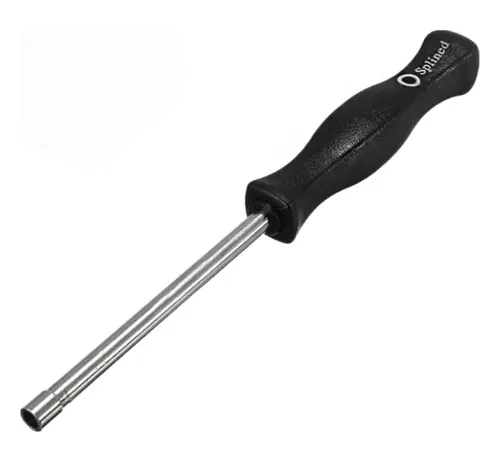
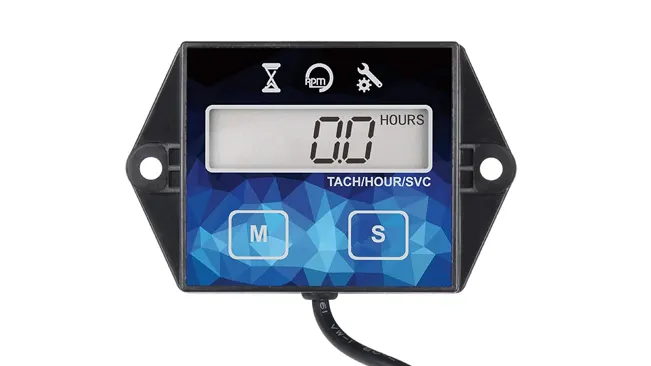






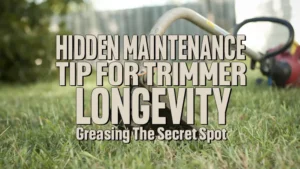





Leave your comment